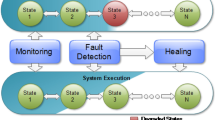Abstract
With the rapid advancement of wireless networking technology, networks have evolved from static to dynamic. Reliability of dynamic networks has virtually become an important issue. Fortunately, a solution to the above issue can be derived from solutions to the Byzantine Agreement (BA) problem. BA problem can be solved by protocols that make processors reach an agreement through message exchange. Protocols used to solve the problem can be divided into Immediate Byzantine Agreement (IBA) protocols and Eventual Byzantine Agreement (EBA) protocols. In IBA protocols, the number of rounds of message exchange is determined by the total number of processors in the network. Even if no faulty processor is present in the network, IBA protocols still require a fixed number of rounds of message exchange, causing a waste of time. In contrast, EBA protocols dynamically adjust the number of rounds of message exchange according to the interference of faulty processors. In terms of efficiency, EBA protocols certainly outperform IBA protocols. Due to the fact that the existing EBA protocols have been designed for static networks, they cannot work on dynamic networks. In this paper, we revisit the EBA problem in dynamic networks to increase the reliability of dynamic networks. Simulations will be conducted to validate that the proposed protocol requires the minimum rounds of message exchange and can tolerate the maximum number of malicious faulty processors compared to other existing protocols.











Similar content being viewed by others
References
Amir Y, Danilov C, Dolev D, Kirsch J, Lane J, Nita-Rotaru C, Olsen J, Zage D (2010) Steward: scaling Byzantine fault-tolerant replication to wide area networks. IEEE Trans Dependable Secure Comput 7(1):80–93
Babaoglu O, Drummond R (1985) Streets of Byzantium: network architectures for fast reliable broadcasts. IEEE Trans Softw Eng 11:546–554
Bar-Noy A, Dolev D, Dwork C, Strong HR (1992) Shifting gears: changing algorithms on the fly to expedite Byzantine agreement. Inf Comput 97(2):205–233
Bessani AN, Correia M, da Silva Fraga J, Lung LC (2009) An efficient Byzantine-resilient tuple space. IEEE Trans Comput 58(8):1080–1094
Biely M, Hutle M (2010) Consensus when all processes may be byzantine for some time. Theor Comput Sci. doi:10.1016/j.tcs.2010.11.012
Broug DR (1992) Logic programming. New frontiers. Kluwer Academic, Norwell
Carroll TE, Grosu D (2008) Strategy proof mechanisms for scheduling divisible loads in bus-networked distributed systems. IEEE Trans Parallel Distrib Syst 19(8):1124–1135
Caruso A, Chessa S (2007) Worst-case diagnosis completeness in regular graphs under the PMC model. IEEE Trans Comput 56(7):917–924
Cheng CF, Wang SC, Liang T (2008) Byzantine agreement protocol & fault diagnosis agreement for mobile Ad-Hoc network. Fundam Inform 89(2):161–187
Cheng CF, Wang SC, Liang T (2010) File consistency problem of file-sharing in peer-to-peer environment. Int J Innov Comput, Inf Control 6(2):601–613
Colon Osorio FC (2007) Using byzantine agreement in the design of IPS systems. In: Proceeding of the IEEE international conference on performance, computing, and communications, vol 97, pp 528–537
De Amorim MD, Ziviani A, Viniotis Y, Tassiulas L (2008) Practical aspects of mobility in wireless self-organizing networks. IEEE Wirel Commun 15(6):6–7
Fisher M, Lynch N (1982) A lower bound for the assure interactive consistency. Inf Process Lett 14(3):183–186
Garcia L, Arnaiz L, Alvarez F, Menendez JM, Gruneberg K (2009) Protected seamless content delivery in P2P wireless and wired networks. IEEE Wirel Commun 16(5):50–57
Huang D (2008) Unlinkability measure for IEEE 802.11 based MANETs. IEEE Trans Wirel Commun 7(3):1025–1034
Jafar S, Krings A, Gautier T (2009) Flexible rollback recovery in dynamic heterogeneous grid computing. IEEE Trans Dependable Secure Comput 6(1):32–44
Krings AW, Feyer T (1999) The byzantine agreement problem: optimal early stopping. In: Proceeding of the 32nd Hawaii international conference on system sciences, vol 8, pp 1–12
Kamil S, Oliker L, Pinar A, Shalf J (2010) Communication requirements and interconnect optimization for high-end scientific applications. IEEE Trans Parallel Distrib Syst 21(2):188–202
Lamport L, Shostak R, Pease M (1982) The byzantine generals problem. ACM Trans Program Lang Syst 4(3):382–401
Maseng T, Landry R, Young K (2009) Military communications. IEEE Commun Mag 47(10):36–38
Pease M, Shostak R, Lamport L (1980) Reaching agreement in the presence of faults. J ACM 27(2):228–234
Siu HS, Chin YH, Yang WP (1998) Byzantine agreement in the presence of mixed faults on processors and links. IEEE Trans Parallel Distrib Syst 9(4):335–345
Silberschatz A, Galvin PB, Gagne G (2008) Operating system concepts, 8th edn. Wiley, New York
Tzeng HY, Siu KY (1995) On the message and time complexity of protocols for reliable broadcasts/multicasts in networks with omission failures. IEEE J Sel Areas Commun 13(7):1296–1308
Wang SC, Cheng CF (2003) Eventually dual failure agreement. Fundam Inform 57(1):79–99
Wang SC, Yan KQ, Cheng CF (2004) Efficient multicasting agreement protocol. Comput Stand Interfaces 26(2):93–111
Won YJ, Choi M-J, Hong JW-K, Kim M-S, Hwang H, Lee J-H, Lee S-G (2008) Fault detection and diagnosis in IP-based mission critical industrial process control networks. IEEE Commun Mag 46(5):172–180
Yang X, Tang YY (2007) Efficient fault identification of diagnosable systems under the comparison model. IEEE Trans Comput 56(12):1612–1618
Younis O, Kant L, Chang K, Young K, Graff C (2009) Cognitive MANET design for mission-critical networks. IEEE Commun Mag 47(10):64–71
Yu M, Zhou M, Su W (2009) A secure routing protocol against byzantine attacks for MANETs in adversarial environments. IEEE Trans Veh Technol 58(1):449–460
Author information
Authors and Affiliations
Corresponding author
Rights and permissions
About this article
Cite this article
Cheng, CF., Tsai, KT. From immediate agreement to eventual agreement: early stopping agreement protocol for dynamic networks with malicious faulty processors. J Supercomput 62, 874–894 (2012). https://doi.org/10.1007/s11227-012-0758-x
Published:
Issue Date:
DOI: https://doi.org/10.1007/s11227-012-0758-x



